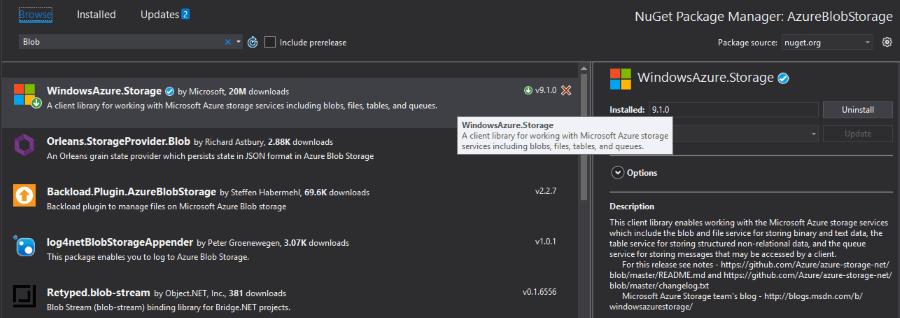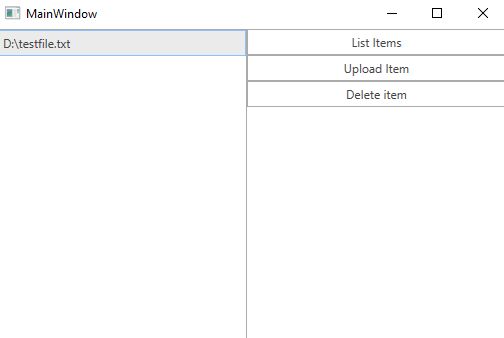Blob Storage
Azure Blob storage is a service for storing large amounts of unstructured object data, such as text or binary data, that can be accessed from anywhere in the world via HTTP or HTTPS. You can use Blob storage to expose data publicly to the world, or to store application data privately. This article will demonstrate how one can use this service from a WPF application and manage the uploaded files.
Set up storage account
For the purposes of this article, you will have to create an Azure Blob Storage account.
Step 1: Create the WPF Application
Create a standard WPF application and add 3 RadButtons and a RadListBox to it. The first button will list all of the files uploaded in our storage. The second button will upload a file and the third one will delete the selected file in the RadListBox.
Example 1: Defining the view
<Grid>
<Grid.ColumnDefinitions>
<ColumnDefinition Width="250" />
<ColumnDefinition />
</Grid.ColumnDefinitions>
<telerik:RadListBox x:Name="radListBox" ItemsSource="{Binding FileNames}" SelectedItem="{Binding SelectedItem, Mode=TwoWay}" />
<Grid Grid.Column="1">
<Grid.RowDefinitions>
<RowDefinition Height="Auto" />
<RowDefinition Height="Auto"/>
<RowDefinition Height="Auto"/>
</Grid.RowDefinitions>
<telerik:RadButton Command="{Binding ListItemsCommand}" Content="List Items"/>
<telerik:RadButton Command="{Binding UploadItemCommand}" Content="Upload Item" Grid.Row="1"/>
<telerik:RadButton Command="{Binding DeleteItemCommand}" Content="Delete item" Grid.Row="2"/>
</Grid>
</Grid>
Step 2: Install the NuGet package
Open the NuGet Package Manager and install the WindowsAzure.Storage package.

Step 3: Define the ViewModel
The next step is to create the ViewModel. It will need an CloudStorageAccount, CloudBlobContainer and a CloudBlobClient which will be used for connecting to your storage account and for managing the data. We also need to implement all of the commands that the RadButtons are bound to.
Example 2: Defining the ViewModel
public class ViewModel
{
private string connectionString;
CloudStorageAccount storageAccount;
CloudBlobContainer cloudBlobContainer;
CloudBlobClient cloudBlobClient;
private object selectedItem;
private ObservableCollection<string> fileNames;
private IFileDialogService fileDialogService;
public ViewModel(string connectionString, IFileDialogService fileDialogService)
{
this.fileNames = new ObservableCollection<string>();
this.ListItemsCommand = new DelegateCommand(OnListItems);
this.UploadItemCommand = new DelegateCommand(OnUploadItem);
this.DeleteItemCommand = new DelegateCommand(OnDeleteItem);
this.fileDialogService = fileDialogService;
this.connectionString = connectionString;
if (CloudStorageAccount.TryParse(connectionString, out storageAccount))
{
// Connection string is valid and the storageAccount variable is set
cloudBlobClient = storageAccount.CreateCloudBlobClient();
// Create a new Container with a unique name
cloudBlobContainer = cloudBlobClient.GetContainerReference("mytestcontainer" + Guid.NewGuid().ToString());
cloudBlobContainer.Create();
}
else
{
MessageBox.Show("Could not connect to storage account");
}
}
public object SelectedItem
{
get { return this.selectedItem; }
set { this.selectedItem = value; }
}
public ObservableCollection<string> FileNames
{
get { return this.fileNames; }
set { this.fileNames = value; }
}
private ICommand listItemsCommand;
public ICommand ListItemsCommand
{
get { return this.listItemsCommand; }
set { this.listItemsCommand = value; }
}
private ICommand deleteItemCommand;
public ICommand DeleteItemCommand
{
get { return this.deleteItemCommand; }
set { this.deleteItemCommand = value; }
}
private ICommand uploadItemCommand;
public ICommand UploadItemCommand
{
get { return this.uploadItemCommand; }
set { this.uploadItemCommand = value; }
}
private void OnDeleteItem(object obj)
{
if (this.SelectedItem == null)
{
MessageBox.Show("Please select an Item");
return;
}
var blockBlob = cloudBlobContainer.GetBlockBlobReference(this.SelectedItem.ToString());
blockBlob.DeleteIfExists();
}
private void OnUploadItem(object obj)
{
var fileName = fileDialogService.OpenFileDialog();
CloudBlockBlob cloudBlockBlob = cloudBlobContainer.GetBlockBlobReference(fileName);
cloudBlockBlob.UploadFromFile(fileName);
}
private void OnListItems(object obj)
{
var blobs = cloudBlobContainer.ListBlobs(useFlatBlobListing: true);
this.FileNames.Clear();
foreach (CloudBlockBlob blob in blobs)
{
this.FileNames.Add(blob.Name);
}
}
}
Public Class ViewModel
Private connectionString As String
Private storageAccount As CloudStorageAccount
Private cloudBlobContainer As CloudBlobContainer
Private cloudBlobClient As CloudBlobClient
Private _selectedItem As Object
Private _fileNames As ObservableCollection(Of String)
Private fileDialogService As IFileDialogService
Public Sub New(ByVal connectionString As String, ByVal fileDialogService As IFileDialogService)
Me._fileNames = New ObservableCollection(Of String)()
Me.ListItemsCommand = New DelegateCommand(AddressOf OnListItems)
Me.UploadItemCommand = New DelegateCommand(AddressOf OnUploadItem)
Me.DeleteItemCommand = New DelegateCommand(AddressOf OnDeleteItem)
Me.fileDialogService = fileDialogService
Me.connectionString = connectionString
If CloudStorageAccount.TryParse(connectionString, storageAccount) Then
' Connection string is valid and the storageAccount variable is set
cloudBlobClient = storageAccount.CreateCloudBlobClient()
' Create a new Container with a unique name
cloudBlobContainer = cloudBlobClient.GetContainerReference("mytestcontainer" & Guid.NewGuid().ToString())
cloudBlobContainer.Create()
Else
MessageBox.Show("Could not connect to storage account")
End If
End Sub
Public Property SelectedItem() As Object
Get
Return Me._selectedItem
End Get
Set(ByVal value As Object)
Me._selectedItem = value
End Set
End Property
Public Property FileNames() As ObservableCollection(Of String)
Get
Return Me._fileNames
End Get
Set(ByVal value As ObservableCollection(Of String))
Me._fileNames = value
End Set
End Property
Private _listItemsCommand As ICommand
Public Property ListItemsCommand() As ICommand
Get
Return Me._listItemsCommand
End Get
Set(ByVal value As ICommand)
Me._listItemsCommand = value
End Set
End Property
Private _deleteItemCommand As ICommand
Public Property DeleteItemCommand() As ICommand
Get
Return Me._deleteItemCommand
End Get
Set(ByVal value As ICommand)
Me._deleteItemCommand = value
End Set
End Property
Private _uploadItemCommand As ICommand
Public Property UploadItemCommand() As ICommand
Get
Return Me._uploadItemCommand
End Get
Set(ByVal value As ICommand)
Me._uploadItemCommand = value
End Set
End Property
Private Sub OnDeleteItem(ByVal obj As Object)
If Me.SelectedItem Is Nothing Then
MessageBox.Show("Please select an Item")
Return
End If
Dim blockBlob = cloudBlobContainer.GetBlockBlobReference(Me.SelectedItem.ToString())
blockBlob.DeleteIfExists()
End Sub
Private Sub OnUploadItem(ByVal obj As Object)
Dim fileName = fileDialogService.OpenFileDialog()
Dim cloudBlockBlob As CloudBlockBlob = cloudBlobContainer.GetBlockBlobReference(fileName)
cloudBlockBlob.UploadFromFile(fileName)
End Sub
Private Sub OnListItems(ByVal obj As Object)
Dim blobs = cloudBlobContainer.ListBlobs(useFlatBlobListing:= True)
Me.FileNames.Clear()
For Each blob As CloudBlockBlob In blobs
Me.FileNames.Add(blob.Name)
Next blob
End Sub
End Class
Step 4: Define the OpenFileDialogService
The only thing left is to define the interface through which we are opening the RadOpenFileDialog. We also need to define the implementation of that interface which will simply open a RadOpenFileDialog and return the path of the opened file.
Example 3: Defining the OpenFileDialogService and IFileDialogService
public interface IFileDialogService
{
string OpenFileDialog();
}
public class OpenFileDialogService : IFileDialogService
{
public string OpenFileDialog()
{
RadOpenFileDialog choosefiledialog = new RadOpenFileDialog();
choosefiledialog.Filter = "All Files (.)|.";
choosefiledialog.FilterIndex = 1;
choosefiledialog.Multiselect = false;
choosefiledialog.ShowDialog();
if (choosefiledialog.DialogResult == true)
{
return choosefiledialog.FileName;
}
return string.Empty;
}
}
Interface IFileDialogService
Function OpenFileDialog() As String
End Interface
Public Class OpenFileDialogService
Inherits IFileDialogService
Public Function OpenFileDialog() As String
Dim choosefiledialog As RadOpenFileDialog = New RadOpenFileDialog()
choosefiledialog.Filter = "All Files (.)|."
choosefiledialog.FilterIndex = 1
choosefiledialog.Multiselect = False
choosefiledialog.ShowDialog()
If choosefiledialog.DialogResult = True Then
Return choosefiledialog.FileName
End If
Return String.Empty
End Function
End Class
All that is left is to set the DataContext to our ViewModel and pass an instance of the OpenFileDialogService and the connection string of the storage account.
Example 4: Set the DataContext
public MainWindow()
{
InitializeComponent();
var connectionString = "myConnectionString";
this.DataContext = new ViewModel(connectionString, new OpenFileDialogService());
}
Public Sub New()
InitializeComponent()
Dim connectionString = "myConnectionString"
Me.DataContext = New ViewModel(connectionString, New OpenFileDialogService())
End Sub
You can find the connection string in the All settings of your storage account in the Access keys section.
Figure 1: Example after uploading a file and listing it in the Office2016 theme
